The recent ‘ASEAN Vision 2025 on Disaster Management’ document provides thoughtful insights on how AADMER can move towards a more people-centred, sustainable and better-networked approach. But these suggestions do not directly address the disproportionate impact disasters have on women.
The UN Security Council’s first resolution on the Women, Peace and Security (WPS) agenda was launched in October 2000. Although it was developed with the plight of women in conflict settings in mind, the WPS agenda itself is not just about conflict or even just about women. It is a transformative agenda that seeks to create sustainable peace, ensure greater participation and facilitate the move from gender inequality to gender justice. In its broader vision the agenda resonates with the objectives of the ASEAN Community post-2015 and is contiguous with ASEAN’s human rights agenda.
It is critical that the WPS agenda becomes an important component of disaster response planning and management. There is ample evidence that women are disproportionately affected both during disasters and in response settings. For example, an Oxfam report in 2005 highlighted how women and girls were extremely affected by the 2004 tsunami, stressing their disproportionately high mortality rates. A 2007 study on disasters in 141 countries revealed that gender differences in mortality rates were directly related to women’s economic and social rights, and that men and boys were given preferential treatment during rescue operations. Beyond the immediate effects, both women and girls suffered more acutely from shortages of food and economic resources.
The four pillars that bolster the WPS agenda — prevention, participation, protection, and relief and recovery — correspond to the objectives outlined in AADMER and could be adapted into its framework. To become a more effective tool, AADMER should incorporate an explicitly gendered perspective on disaster response.
AADMER does currently take into account vulnerable groups in disaster settings and has specific provisions for this purpose, like the inclusion of and consultation with these groups in planning and management. But the agreement does not explicitly mention any specific focus on the forms of vulnerabilities unique to women, including the increase in sexual and gender-based violence in post disaster settings. Instead ‘vulnerable groups’ mentioned in the agreement should be understood to implicitly include women.
Article 6 of the agreement aims to include local practices and knowledge into disaster management processes. But it does not acknowledge the active role many women can, and often do, play throughout the various stages of disaster response and rehabilitation like procuring food, clothing and shelter through their own informal networks before aid arrives. This locks women in a victim narrative and does not recognise their role as valuable actors in disaster management. The absence of an explicit gendered approach in AADMER hence reduces the sustainability of rebuilding and rehabilitation efforts.
Post disaster this can further increase women’s vulnerability and economic insecurity. Persistent gender inequalities are only exacerbated in a crisis setting. A gendered perspective on disaster planning and management may significantly reduce these risks.
There are various possible entry points to incorporate the WPS agenda in AADMER. Article 3 of AADMER, for example, outlines the need to extend disaster risk reduction efforts in order to incorporate sustainable development policies at all levels and involve all relevant stakeholders, including local communities. As mentioned earlier, Article 6 specifies the importance of strengthening community participation as well as promoting and utilising local knowledge and practices. This could potentially include formalising women’s ‘informal networks’, for example, through the creation of local women’s response teams. These articles provide avenues through which ASEAN could help develop more resilient communities.
Indonesia and the Philippines have already embarked on the WPS agenda through their specific WPS National Action Plans that address women’s protection during conflict settings and their participation in peace building efforts. This is reflected in a 2014 Indonesian Presidential decree and in the Philippines through the National Action Plan on Women, Peace and Security (NAPWPS). These could be ‘launching pads’ for incorporating the agenda in disaster settings as well. But for this to be successful it will be crucial that more developed ASEAN states assist their ASEAN neighbours in areas where they may lack the financial and technical capabilities or necessary skills and training programs.
Singapore, for example, can certainly step in to fill this void. Singapore could play a leading role in promoting and coordinating the WPS agenda in AADMER as well as creating strong monitoring and evaluating systems. Supporting research investigating gender sensitive early warning systems, and providing gender-sensitivity training for disaster response teams are two possible areas for greater collaboration and involvement.
What is also needed is the collection of greater disaggregated data at a regional level to facilitate a more nuanced picture of the gendered impacts of disasters across the region. It will also be necessary to further investigate how discourses on risk and safety following a disaster are shaped.
The integration of ASEAN into a single regional market through the ASEAN Economic Community compels Singapore to work towards greater stability in the region. In such an interconnected community disasters that happen elsewhere can have repercussions across the entire region. The increased movement of people following a disaster — as many succumb to desperate measures to survive due to heightened economic insecurity — can evolve into issues of national security, for example human trafficking, where Singapore becomes a crucial node in the system or a destination point. A disaster in one area has transnational implications.
Natural disasters are not discerning. They affect all: men and women, rich and poor. It will be imperative to support the WPS agenda using the AADMER platform to create a more disaster resilient region. This should be a key goal for Singapore as chair of ASEAN in 2018.
Tamara Nair is a Research Fellow at the Centre for Non-Traditional Security (NTS) Studies at the S. Rajaratnam School of International Studies (RSIS), Nanyang Technological University, Singapore.

